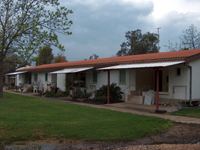Founded 1949 | Population (2015) 538 Local time Sunday 7:53 AM | |
 | ||
Founded by Surviving fighters of the Warsaw Ghetto Uprising, former Jewish partisans and other Holocaust survivors. Name meaning The fighters of the ghettos Weather 17°C, Wind SE at 27 km/h, 53% Humidity | ||
Lohamei HaGeta'ot (Hebrew: לוֹחֲמֵי הַגֵּיטָאוֹת, lit. The Ghetto Fighters) is a kibbutz in northern Israel. Located in the western Galilee, it falls under the jurisdiction of Mateh Asher Regional Council. In 2015 it had a population of 538.
Contents
Map of Lohamei HaGeta'ot, Israel
History
The kibbutz was founded in 1949 on the coastal highway between Acre and Nahariya, on the site of the depopulated Arab village of al-Sumayriyya. Its founding members include surviving fighters of the Warsaw Ghetto Uprising (notably Icchak Cukierman, ŻOB deputy commander), as well as former Jewish partisans and other Holocaust survivors. Its name commemorates the Jews who fought the Nazis.
Economy
In the mid-1980s the kibbutz acquired the Tivall vegetarian food products factory, which has become a mainstay of its income. Other branches include a large dairy and agriculture and a bed and breakfast. The kibbutz is currently undergoing a process of privatization. It operates a bed and breakfast for tourists to the area.
Archaeology
Alongside the kibbutz are the extensive remains of an aqueduct which supplied water to Acre some 6 km away, until 1948. The aqueduct was originally built at the end of the 18th century by Jezzar Pasha, the Ottoman ruler of Acre, but was completely rebuilt by his son, Suleiman, in 1814.
Museum
The kibbutz operates the Ghetto Fighters' House, a history museum commemorating those who fought the Nazis. Adjacent to the museum is a large amphitheatre used frequently for concerts, assemblies, and ceremonies hosted by the museum.
